Home sweet Animal Farm
Villa Villekulla
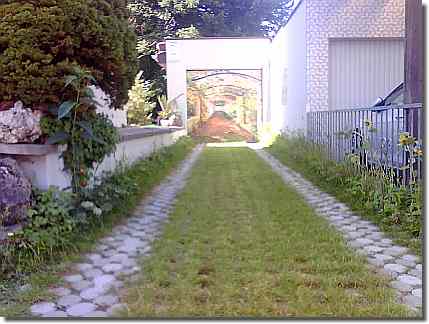
30 square meters (~ 223 sf) unsealed driveway: you are welcome!
Entitled like George Orwell's book, but that's all that's common. The outskirts' garden kept rather close to nature offers numerous species a hiding place and a place for living. Water biotopes in the neighborhood and own bird bathes enrich the habitat and provide a living space even for amphibians. The sunny and sandy south-west incline is appreciated by lizards. Where lizards live slow-worms are not far. Not only a lot of small animals and birds appear, also mammals like squirrels and hedgehogs.
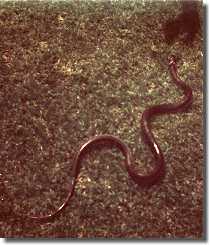
Not a rattle, but a ring snake
Even »exotics« show up. For instance
hornets, toads, cross-vipers, black woodpeckers or during the
winter feeding even ten(!) pheasants at a time.
A view through the window - especially with the binoculars - often
is much more interesting than watching TV.
Each of the animals becomes used to humans more or less. One gets on with each other or one simply keeps out of the others' ways. If established the contact quickly surpasses the sole acceptance of the feed opportunity or the judgement »mostly harmless«. Often a friendly trust relationship arises which even includes direct communication.
Enlightening: I needn't go to the zoo - the zoo comes to me.
Just visiting
Extra animal stories from the nearer wild - Farm Plus extension:
MORE
Aquarius
Extra watering of the newly planted wall had chased
some lizards. The next evening rustling again when I retired.
On the third evening six lizards expected the drinks delivery.
Without timidity they sleeked the water drops from the leaves and
during the following days they drunk out of water puddles I had
made just in front of them. And hand-feeding worked as well.
Real aquanauts: for some years a pair of grass frogs stayed in the
garden, hardly separated by more than one meter. On hot days they
sought cooling in the freshly filled bird bath and it was almost
possible to touch them.
Fairies' curtain
Exciting is to watch the brood care of the daddy-long-legs spider (vibrating spider). The mother spider watches over the egg cocoon and later over the baby spiders for some days. When one puts a prey animal in the web, the spider mom very carefully steps across over its babies. Once the young spiders had chosen a fluorescent tube for a first rest. Whenever it turned warm they side by side in dozens roped down an appropriate distance. It looked like a hazy shade of curtain. When after switching off the lamp turned colder they climbed up step by step again.
Fast food
Eck - feeding a spider, is this really necessary?
During a walk-around in the garden I discovered the web of a house
spider in a dry stone wall. With a shaky blade of grass the almost
full grown spider (diameter like a coffee cup) I succeeded to lure
her out of her burrow. Even more, she followed the air draft until
the edge of the web and angled for it with her legs. There is
somebody hungry! Thus I waited for some mosquitos to approach me,
feed, there it is. I bent down to the web with the gnats on my hand and
there she came immediately. From the edge of the web she grabbed for my
hand and slowly pushed onto the palm. She just took some gnats at
once and leisurely retired into the burrow. In the following period
Charlotte reacted on her name (i.e. certain vibration) and left the
borrow and carefully took gnats I offered her between my finger
tips. I presented them over Charlotte's web and she rose and
supported herself against my fingers with her front legs. Some
spectators turned very pale by that...
Once I had found some ant eggs. She accepted one (my offer ;-),
but did not know what to do at first. For some ten seconds she
turned it between her jaw claws until she bit finally. Succeeding
she seemed to be really surprised, because the food was already
ready! (Spiders do not own jaws for biting but inject digestive
secretions with their jaw claws and suck the pulp then.)
Wasp douche

Terrace Fountain and Blue Lagoon, spa and wasp douche
Especially the small things often surprise. At a decoration well wasps picked up cooling water for their nest under the hot tile roof. Most of them landed on the rim and crawled to the water, whereas the pros made their touch down on the water surface directly. Some beginners, however, sled or tumbled into the water at first. Therefore I was worried when in the evening I noticed a wasp balancing around the outlet, not that she would have been washed away. The concern was completely baseless - with caution and painstakingly she successively stretched her abdomen, head, legs and each wing separately under the waterfall and washed herself thoroughly. From day to day the numbers of workers taking a shower increased.
Spa
Enjoyable solar terrace fountain has a big fan club.
For stray cats, thirsty squirrels and various bird species it
provides a spring and for the latter a bath. The blue tits are
really nuts on it. The small basins obviously afford the right
whirlpool size and the flowing water supplies freshness and can
just be used as shower. And when I intent to pass they do not flee
or so, but really rumble at me out of their bath tub -
»Don't disturb! Don't you see we are taking a
bath?«
- and make me turn in a distance of more than one
step.
The birds
Early bird, of course, all the culture followers like
mice, blackbird, magpie, jay, squirrel, titmice (six species),
woodpeckers and robins are well represented. Especially the last
get very human friendly. Well, the young titmice now and then land on
one's hand waiting for feed.
And with the great spotted woodpeckers it's another matter. I can
remember those times they hastily left the garden, when one just
had moved behind a window. Nowadays one is clearing the path of snow and
in less than two meters distance a woodpecker clambers crying about
a tree: »bird fat balls are out!« Hardly one had mounted
a ball and is just turning away the hungry woodpecker immediately
clung at it. Nuthatch and treecreepers are guests, too.
Even bats (mammals, no birds but they fly as well ;-) come for a
rendezvous speedy and smart, the swallows of the night.

Also in the garden: Queen of the Night
Don't talk to strangers?
Even if behavioral scientists had their problems with it in the past - animals talk to us. They watch us, judge us - obviously beyond of mostly harmless - and consider us worth making contact. Not only that they know where feed is available or that there is somebody to feed them. It is even more than just begging for feed. During the years I repetitively had epiphanies. So on flight level as high as my head a great tit passed me almost in hover flight loudly beeping when I opened the door of the hut in order to enter. It was clear, the bird wanted to caught my attention intending to look for feed inside the building and I should not close the door. Because when I just said anything, not even attempting to leave the hut again, the bird hurried out.
Vulture Wally
Evidently the tit was facing problems with its molt or
was sick. The flight was ponderous due to probably missing flight
feathers, the pea sized head even was completely naked. All chased
it off the feeding site or even picked on it. One day I discovered
it some meters away in a bush and asked it with an inviting gesture
to approach. Almost immediately it flew to me and started a silent
whisper »beep, beep, beep ...
«. Less than a hands'
width away it took the offered nut crumbs. And as time passed by
the feathers grew again.
Wag the squirrel
Enemy protection can be gained by nearness to humans. The
adult birds, however, do not really appreciate when one stands near
their nesting box. One day loud and angry twitter of a couple of
great tits drew my attention to a black squirrel actually hanging
and fingering at their nesting box. I carefully approached and tugged
at the squirrel's tail. It took up like a rocket! immediately
afterwards the tit parents really sang for me so I suppose only
less was missing and they would have slipped a worm to me
expressing their gratitude for the support.
Some days later I noticed the male tit carefully stalking up on
a dozing red squirrel and pulling its tail.
Temporary fellow-tenants
Everything and all for nothing but the cat:
MORE
Even now and then the scientific curiosity or the
helpfulness demand more. Then deeper contact takes place. Who does
not want to thoroughly watch the metamorphosis of frogs? Or who
wants to let perish a helpless animal baby?
That enables the deeper concerns about the individual behavior and
the nuanced interactions with humans. Thereby it just scratches a
bit the rather mechanistic approach of the traditional behavioral
biology.
Not to mention the real domestic animals or pets.
Real love for animals: during the bicycle tour discovering a puddle with tadpoles just before drying up and saving them in the drinking water bottle. Or even like my aunt: cycling home, returning with the camper and filling up the puddle out of the drinking water reservoir.
Thieving magpie
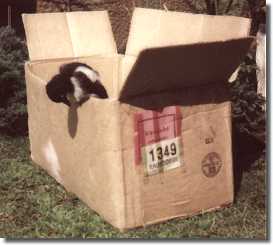
They have a magpie in the belfry...
Entering as foundling brought by a friend, the magpie
chick was called Hansi. (It is not unusual that young magpies leave
the nest although they are not yet fledged. In general they are
fed by the adult birds further on.) The magpie chicken showed very
great shyness concerning humans and tried to flee. Although he was
obviously exhausted he refused any food offered. Even water he
didn't accept.
Not until I spent some time, used tricks and cunning and a little
bit force as well, I was able to stuff a small ball of minced meat
into his throat and force him to swallow. But then Hansi accepted
the second piece voluntary and asked for more.
After that he was allowed to make himself comfortably on the
backrest of a kitchen chair and surprised us because he started to
turn restlessly under crying, better whining - young hazels are
house-trained! Thankfully he accepted an offered piece of newspaper
and then fell asleep.
Hansi was allowed to move by his own choice and slept on a
backrest of a kitchen chair. In the house or in the garden he ran
after one. The most popular game was turning stones. I rolled over
stones in order to find adequate nourishment. Hansi had great fun.
Even when he obviously had no more hunger, he curiously checked the
base of every stone I turned.
He showed no urge to fly as if he didn't know he would be able to
do so. Even when he should have been full-fledged. Not until I softly
threw him in the air he started to flutter. First he had sought
refuge in the trees higher and higher and spent moaning the whole
night there. On the next morning he tried to directly hit the open
kitchen window in the second floor. Too high! Out of the roof gutter
he managed to get back to the trees. Second trial: too deep! Again
back in another roof gutter to the trees. Not until I came back from
school he took heart. From limb to limb and tree to tree he made
his way downstairs and touched down in the lawn with a somersault
after slithering over a sun umbrella, but he was in fear of
punishment. After he calmed himself down and had eaten and drunk
for three days he felt asleep for a complete day.
Even so when he learned to fly he stayed with us on his own
decision. He slept on a clothesline in the cellar with a window
providing free access. In the morning he sat on the windowsill of the
kitchen waiting that somebody let him in for
breakfast. Then he followed his people to the car, to school, to
the shopping tour ... He landed on one's shoulder on demand (or
even so). Imagine that: suddenly a big black and white bird
dives from the deep sky stopping in last moment to land soft like a
feather on one's shoulder. Witnesses were upset.
During the day he strolled through the house and the garden. In
the evening he »told« sitting on one's shoulder, what had
happened during the day.
The play instinct was very strong. He liked to fill sleeping
grandpa's ears with gleaming pebbles. In the house he was a fan of
glittering paper of sweets. First he watched me snipping it from
the table, then he flew with it on a cupboard and let it glide to
the ground. The only thing he theft was father's pipe stopper made
of shiny metal. All other valuable and shiny things we kept away
from him.
Indoor he seldom flew, but when then impressively. In general magpies
are not considered as good flyers, however, when he poised on the
spot or even backwards(!) like a hummingbird one wouldn't claim so
further on.
His social behavior was striking. Thereby an inhibition existed.
Never he etched closer with his beak pointing towards one's face or
even eyes. Within a certain distance he was forced to turn his head
to the side. (Well, therefore the proverb: »A crow does not
pick an other's crow eye.«) He, however, insisted to examine my
teeth - starting with carefully scrapping to fierce knocking. He
seemed to be deeply impressed.
And sometime I risked one eye at least when he intended to
practice social body care: obviously the aesthetic feeling of
magpies and humans is not very different. He just pulled out the
hairs in my nose. Spreading hears of my eyebrow he bent in form
with tongue and beak edge. If they were too unruly, he picked them
out. He de-twisted my eyelash very carefully and arranged the hairs
parallel. He never pulled out one of them.
After several weeks two adult magpies entered the garden and
carefully etched closer and closer day by day. Somehow they made
him clear that he usually belonged to them. Finally he toured with
them. This seems not to be unusual. I have already heard and read
of that adult magpies fetching young magpies from human custody.
In real we were quite happy, because he showed no shyness towards
people, played sometimes the (uninvited) surprise party guest
in the neighborhood and he had just been caught already. Now and
then he visited us and obviously he could convince the adult
magpies that we were harmless. Because even they came closer,
too.
Hedgehogs - Meckis and Mickis
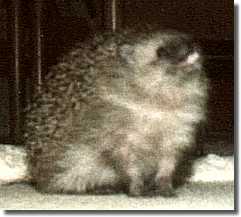
Hedgehog Mecki I is in the house
Easy convention - all male hedgehogs were called Mecki,
all female ones Micki.
Only animals with underweight (under about 500 g; about 1.1
pound), which strayed around in late autumn and would have not
survived a hibernation were helped to get through the winter. Most
hedgehogs, however, one gets in that way are sick or have parasites
and worms. Consulting the vet is almost obligatory.
Nevertheless, passing the winter is a delicate job, therefore in
some regions the private care is not permitted. We get off, too.
Very important: do not offer undiluted milk or better milk at all!
The first hedgehog called Mecki joined us for winter in the middle
of September. He had a weight of 85 g (less than 0.19 pound)
only. First he formed the popular hedgehog ball, but then he got
confidence. He really made friends with us. Due to moving free
through the flat (covered with newspaper, hedgehogs aren't
house-trained!) Mecki followed and used almost every occasion to
snuggle. He let himself turn on the back, let his belly scratch
gently and therefore in delight bit in one's fingers. In this
position he liked to be fed, too. After that he slept in one's arms
or on one's knees. He showed no shyness towards humans and reacted
on them, e.g. by switching to day activity.
In early spring he was set free with a weight of more than
1 100 g (2.4 pounds), but staid in the vicinity.
A female hedgehog showed the complete range of the attitude
towards humans. Micki was to be seen just two times. Once when she
arrived from a chicken farm and ticks and fleas were removed and
twice when she was set free with imposing 1 300 g (2.9
pounds). In the meantime one saw a wool wood tangle only, which
moved to the food bowl, smacked and retired after a while.
Only once Micki freaked out: when I presented her a hen's egg the
sound of my finger nails on the eggshell made her jump just like a
rubber ball. Obviously she was familiar with eggs.
Rabid Bambi
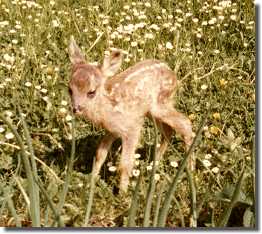
A handful of deer
Emergency case called Rehlein (Engl.: Deerly) came as
orphaned foundling to my aunt. His mother had been ran over by a
mowing machine.
My aunt brought up the really tiny and helpless baby with the
feeding-bottle and he got completely tame. He showed no shyness
towards people. He got along with my aunt's cats, too.
First the deer had the permission to move through the entire
garden. After he got older he liked to ram his head and later his
horns with increasing pressure against one's legs or whatever was
in his way. That wasn't as harmless as it seems, because one didn't
recognize the danger of the situation. He came up slowly walking
and with bowed head, aimed and then he pressed with maximum force.
A typical behavior, which also Konrad Lorenz already described in
He talked to the cattle, the birds and the fishes.
Finally my aunt gave him away to an open-air enclosure. But she
visited her Rehlein regularly.
Summer feed
Extraordinary cold July made it hard for the great
titmice to rise their second breed. One was not able to stand by
and watch the misery any longer. A handful of sunflower seeds put
on the veranda table should support the completely exhausted adult
birds. They were accepted with thanks. When the young birds left
the nest their parents brought them to the table. After a critical
view onto the humans they landed aside one, skipped to the seeds,
snatched one and pecked it open on a neighboring twig so far as
they were not fed. The adult birds also discovered that the seeds could
be easily clamped into the stitches of the tablecloth for
opening.
The snack stall got around. A couple of bluetits, two nuthatches
and several crested tits approached, too. Temporarily also a red and a
black squirrel and even two jays glanced around.
In the morning the flock of birds was already awaiting one, if not
even the crested tits flew into the house. It was hard to have the
heart to stop it again.
Meanwhile the summer feed has become established and has gotten
around. Even by marsh tits, robins, chaffinchs and woodpeckers.
During the summer and winter feeding as well one is amply rewarded
by the sight of the feathered friends sitting in the tree like
Christmas balls.
The turn around one
Caution - don't bite the hand that feeds me!
No fear of contact, not in the least
Extensive winter feed had made the (European) squirrels
gain trust. During summer feed one of them, Eric the Red, carefully
moved closer to the table and much more carefully took the nut
between one's fingers. Also Redder was almost in this state. One day
he sneaked around the corner of the house, just approaching us.
Alarmed he turned round and jumped away. Ten feet further he
suddenly stopped, looked over his shoulder and threw a long glimpse
on the humans - well, the notorious BIG nut dispensers, mostly
harmless
. He turned round, then almost ran over our feet and
waited on the table for the nut he picked out between my fingers
now, too.
After countless feedings one can claim some kind of friendly
relationship. Once suffering hefty sciatica and almost immovably
sitting on a garden chair I was not able to feed, he slowly
approached, climbed up a chair leg and quietly(!) sat down on my
knees. After a along and intense view in my face - »Something
wrong, Bigfoot?
« - he carefully edged away.
A lazy Sunday afternoon. In a branch fork about eight feet above me
a squirrel was preparing to a short nap after a nut snack. I stretched
out in my garden chair to browse in a book. Suddenly a loud and
clear »Hu Hu?
«. I rose my view and noticed the
squirrel's head nodding to me down from the branch »Hui ui ui!
Huju ui jui ujuu...
«.
Meanwhile, within less than a year, at least half a dozen squirrels
is more or less handtame. And over the thumb at least fifteen
squirrels are guests.
Master and Commander
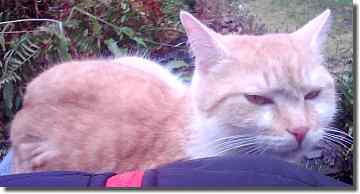
I don't own a cat. My knees - Micky's secondary residence
Evident, the way to one's heart is through one's
stomach. Thus one should be convinced the feed does it. But the
taming also works through the respect one offers to the »wild
creatures«. If you do not press them hard you will quickly
recognize that the human presence is definitely appreciated. After
all one keeps away predators, like e.g. bird of preys, and conveys
safety, in words a safe rest and sleep location. When you warn
against a cat on still hunt with loud hand clapping, it can happen
that the squirrel just not bold enough to get close during feed
sweeps around your feet (thankfully?), although it could have
easily steered clear off you.
In general all warn against cats and foreign languages are
obviously understood interspeciesly, in hunting jargon called
»mobbing against the enemy«. I am neither a hunter nor I
am usually branded. So what happens, when the cat jumps on my
knees? For sure fifty meters one can trace the travel or better
secret path of the cat. When finally approaching me the hue and cry
finds its end. And when it lays on my knees, I am obviously
expected to control the cat. Then with ease one dares to etch
closer than two meters for feeding. Also some kind of respect.
Extend the [TOUR] to some Cats' Farm insights.
